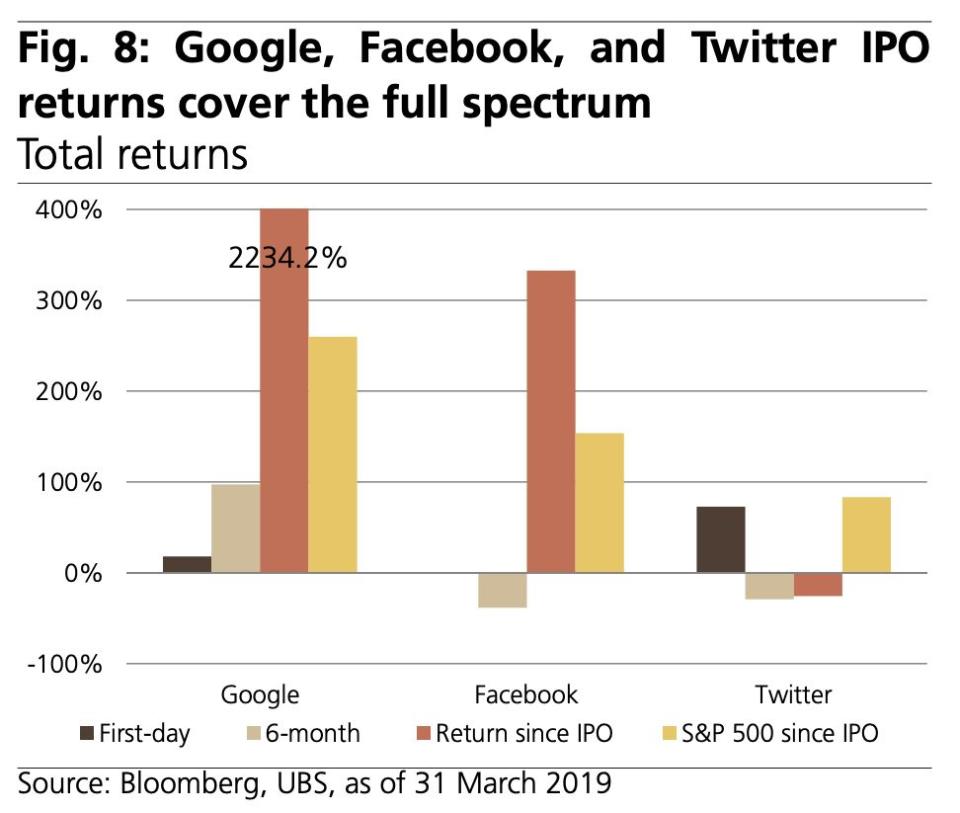Key factors to consider before jumping into hot IPOs, according to UBS
It’s gearing up to be a hot year for IPOs.
But for those looking to get in on the action, one strategist warned that investors should consider all of the risks before jumping in.
Ride-sharing company Lyft kicked things off this year when it went public on March 29, and a slew of other unicorns are anticipated to IPO this year. A unicorn is a private company that has an estimated valuation of $1 billion or more.
Lyft’s rival Uber, WeWork, Airbnb, SpaceX, Pinterest and Slack are some of the other highly-anticipated unicorn IPOs slated to happen this year, but Jason Draho, head of asset allocation at UBS, recommended looking at past IPOs and their performance patterns before deciding whether or not to participate.
According to Draho, unless investors can get an allocation during an IPO, buying it on the secondary market is a much less attractive investment. “Since 1980 the average first trading-day return is 18%, while in the six months and three years after the first day IPOs perform roughly in-line and below risk-adjusted market returns, respectively,” Draho explained.
Draho pointed to data compiled by University of Florida professor Jay Ritter. Ritter put together an IPO data set which includes 8,500 IPOs in the U.S. from 1980 to 2018. Positive first-day returns are extremely common occurrences for IPOs, according to Draho. “In the U.S., the average first-day return has been 18% over the past 40 years. There’s a wide range around this average, with some returns well in excess of 18%.” Nevertheless, Draho noted that it is also important to remember that “investment banks stabilize the share price in the secondary market to keep it from falling below the offer price on the first day.”
For those that can snag an IPO allocation, returns on the first trading day may appear super attractive. “That’s because the typical opening price already accounts for the bulk of the first-day return, about 90% on average. Thus, investors who buy at the opening should expect a minimal first-day return,” Draho said.

However, investors who purchased on opening day at closing price haven’t seen as juicy returns, especially if they hold the shares for longer than six months, according to Draho. “In an efficient stock market, a portfolio of IPO stocks shouldn’t consistently outperform the market, after controlling for differences in risk. But they also shouldn’t underperform on average, which is what they’ve done over a multi-year period,” Draho said.
Draho included six-months post-IPO as a critical period because that is generally when lock-up periods expire. Lock-up periods are when underwriters and pre-IPO shareholders are prevented from selling shares during the agreed-upon period, which is typically six months. Thus when lock-up periods expire, some amount of selling occurs and puts pressure on the stock price regardless of fundamentals, Draho pointed out. “Over the full sample period the average six-month return is about 6%, or about 2-3% excess, but from 2000 onwards both are negative. The absolute geometric average 5-year return was 11%, but the excess return fell to -2% and it was worse in the 2000-2016 period,” Draho explained.
Investing in an IPO can be very risky; however, companies with revenue over $1 billion and with backing by growth capital outperform their smaller counterparts over the span of three years. “This superior performance, coupled with smaller first-day returns, suggests that larger established companies are safer IPO investments,” Draho argued.
Overall, an IPO’s first trading day performance is not completely indicative of its future performance. Draho alluded to Google (GOOGL), Facebook (FB) and Twitter (TWTR) as prime examples of his thesis.

Twitter surged the most during its first day of trading, a whopping 73%. But since the closing price on its first day, shares are down more than 25% compared to the gain of 83% for the S&P 500 (^GSPC) during the same time period. Facebook shares, on the other hand, tumbled 38% during their first six months of trading, but have soared 333% since the close on the first trading day. Google saw the most average first-day performance. Shares jumped 18% on the first day and have skyrocketed 2,234% since then.
“These results show the limitations of using average returns to draw conclusions about IPO performance,” Draho said. “Dispersion is high in the early months and years after these companies go public when the market is still learning how to value them. It’s also partly why first-day returns aren’t predictive for subsequent returns.”
—
Heidi Chung is a reporter at Yahoo Finance. Follow her on Twitter: @heidi_chung.
Follow Yahoo Finance on Twitter, Facebook, Instagram, Flipboard, LinkedIn, and reddit.
More from Heidi:
Inverted yield curve could be a good thing for stocks: Citi
Why Warren Buffett isn’t buying the Lyft IPO
Legendary investor Alan Patricof: A company's leader is more important than its product
